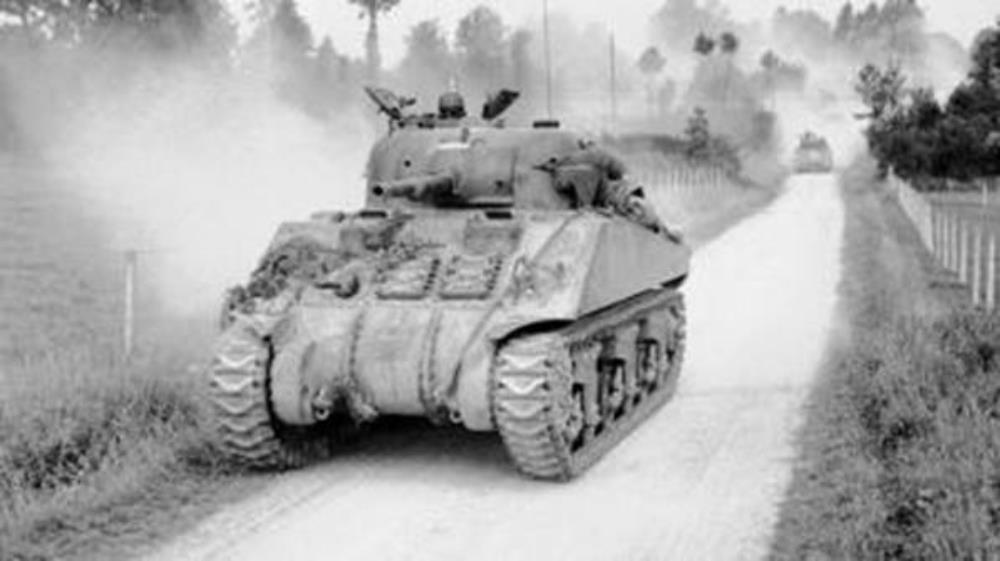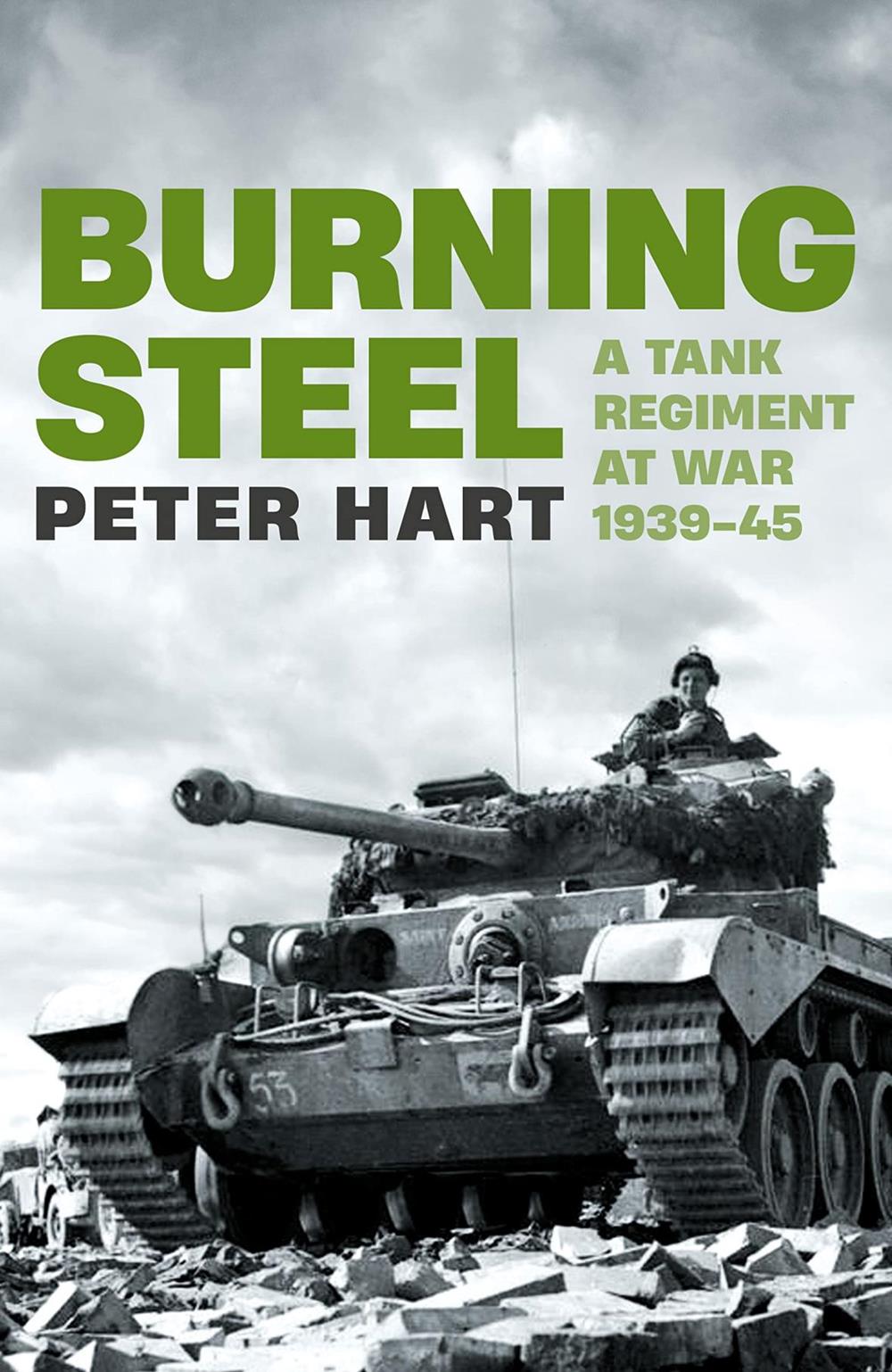Burning Steel
– a tank regiment at war 1939-45
The horrors endured by a Scots regiment are told in the soldiers’ own words – “Burning Steel” by Peter Hart.
Reviewed by Saul David, The Times Wednesday May 04 2022, 5.00pm
 Sherman tanks advancing towards Vire, France, in August 1944
Sherman tanks advancing towards Vire, France, in August 1944
On June 26, 1944, Sherman tanks of the 2nd Fife and Forfar Yeomanry got their first taste of combat when they attacked strong German positions near the village of Cheux, in Normandy, as part of Operation Epsom. It was a brutal introduction to war, costing the regiment nine tanks and a number of lives. Charlie Workman, a young lieutenant from Musselburgh in East Lothian, recalled:
“There was a ‘bang’ and I was brewed up . . . I was literally blown out of my tank. I came to on the ground – I was quite uninjured. The sun was shining, the cornfield all round. There was a ‘sack’ lying beside me. My troop sergeant came up, his tank was just behind me, and this ‘sack’ of stuff started screaming at me, ‘Shoot me! Shoot me, sir! I’ve been a good soldier, please I can’t stand the agony, please, please shoot me!’ This was my driver, who had been very badly burned up; there was a fire in the front of the tank. I took out my revolver and I couldn’t find a face. I couldn’t find anything — there was nothing left of ‘him’ except a voice.”
Fortunately for Workman, the driver died before he could shoot him, but it was a horrific experience that, as the campaign unfolded, became all too commonplace. The American Sherman M4 medium tank had its advantages: it was fast, reasonably well protected and armed with a decent 75mm dual-purpose gun. Yet as Peter Hart explains, it also fell between two stools: “The armour was rather too thin for a true infantry support close-support role, while in any tank-versus-tank duel, it ended up being both under-gunned and under-armoured in comparison to the rather more ‘complete’ new German tanks such as the Panther and Tiger.” Once hit, the Sherman had a tendency to burst into flames — hence the injuries to Workman’s driver — and was ghoulishly nicknamed the “Ronson” after the popular American cigarette lighter.
Armoured warfare, as Hart makes clear, was a uniquely terrifying experience. Even if you did escape a burning tank, there was the possibility of being “brutally cut down by the machine guns and hand grenades of German infantry”. On the other hand, the 4in armour did provide protection against most battlefield weapons — small-arms fire, shrapnel and lighter shells — and the crews who fought within its claustrophobic confines became a tight-knit unit.
Burning Steel is the story of one such tank regiment, part of the famed 11th Armoured Division, in the Second World War. It is based on an oral history project that Hart and his colleagues at the excellent Imperial War Museum Sound Archive undertook at the turn of the century when they interviewed surviving members of the 2nd F&FY. Such an approach has strengths and weaknesses: it gives the reader a raw and visceral, bird’s-eye view of the action from the men who were there, yet it also relies too heavily on the accuracy of septuagenarians’ memories and sacrifices broader context for overlong passages of direct quotation.
Hart takes 80 pages to get to the action as he covers the formation and training of the 2nd F&FY and the frustration felt by its members as they wait for an opportunity to prove their worth.
They are, it should be said, an interesting bunch. The officers were drawn from the “great and the good” of Fife and Forfar, including landowners, professionals and businessmen. The NCOs were former regular soldiers, territorials or men with local standing such as factory foremen and bank clerks, while the men worked on farms, on estates, in shops or in factories. “Although socially disparate,” Hart says, “they were collectively proud of their ‘Scottish’ heritage and their unit’s traditions.”
Undoubtedly the most impressive was William Steel Brownlie from Greenock, who was just 20 when he joined the regiment as a troop commander. Emerging from battle after battle with his Sherman and crew intact — including one horrific day during Operation Goodwood when the 2nd F&FY lost 37 tanks — he seemed to have an instinctive feel for armoured warfare and was bold and aggressive without being reckless.
In one action he was awarded the Military Cross for volunteering to remain behind during the night with his tank to stem an enemy advance, and later broke up an attack by “destroying five enemy tanks and self-propelled guns, killing a large number of infantry”. He downplayed the heroism by saying he “most certainly did not ‘volunteer’ ” and that the figures for enemy vehicles destroyed did not come from him. He added: “I’ve always been suspicious of citations, preferring personal versions of how one got a gong. Mine is that I stayed out all night.”
Amid the courage and self-sacrifice are darker stories of cowardice, self-preservation and brutality. One trooper admits that he tried to shoot an unarmed prisoner in the back, but the weapon misfired; another that wholesale looting was commonplace and rape of German women not out of the question. “It would be pointless to say we didn’t do it,” he admits. “I’m sure it went on. If it wasn’t rape, then it was certainly next to it. A packet of fags, a bar of chocolate and ‘jiggy-jig’ behind the bushes. To me that’s rape the same as anything else.”
We could hear more from the author. He writes well and his judgments are sound. Notwithstanding the limitations of oral history, he has penned a fine memorial to those members of the 2nd F&FY who did not come home. The regiment fought gallantly in most of the major engagements of the North-West Europe campaign: Normandy, Operation Market Garden, the Ardennes Offensive, the crossing of the Rhine and the drive to the Elbe river. On May 2, 1945, it liberated the former Hanseatic port of Lübeck on the Baltic, thus preventing the Soviets from occupying Denmark, and a few days later the war in Europe ended. With so many killed and maimed — the 11th Armoured Division as a whole had suffered 10,000 casualties and over 2,000 dead — was it all worth it? Most survivors thought so. “I was a conscript,” wrote one. “I did not object; someone had to fight this war. I did what I had to do.”
Burning Steel: A Tank Regiment at War 1939-45 by Peter Hart, Profile, 462pp; £25
